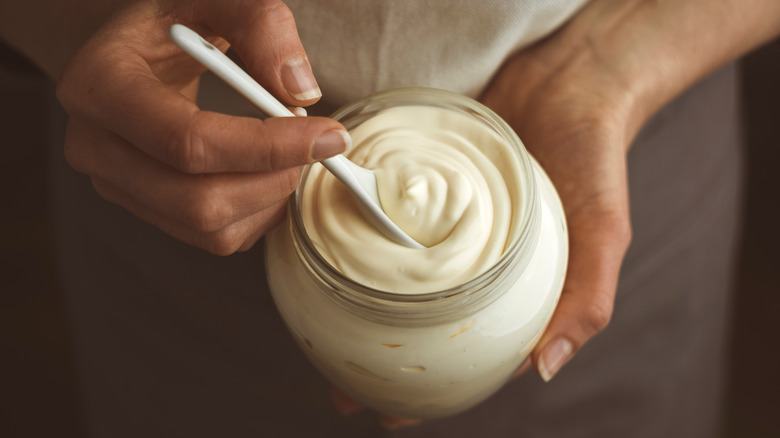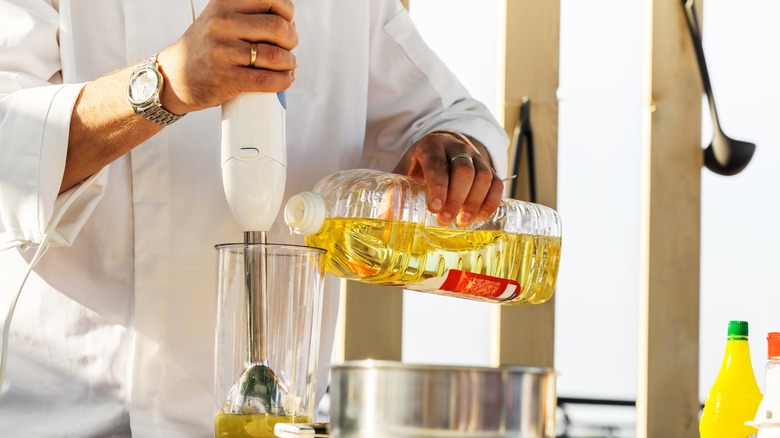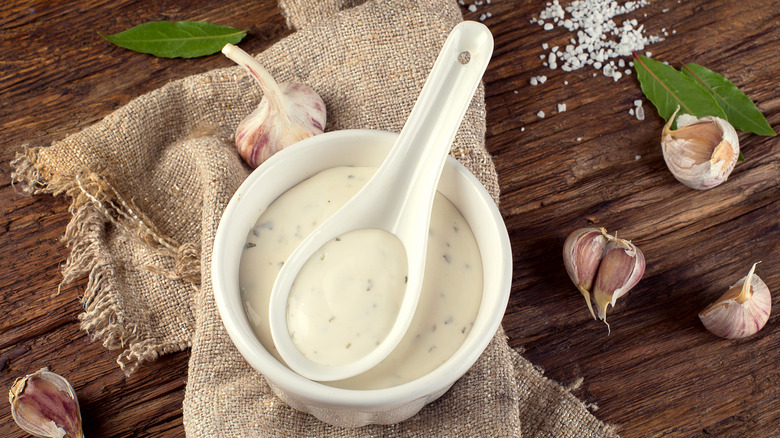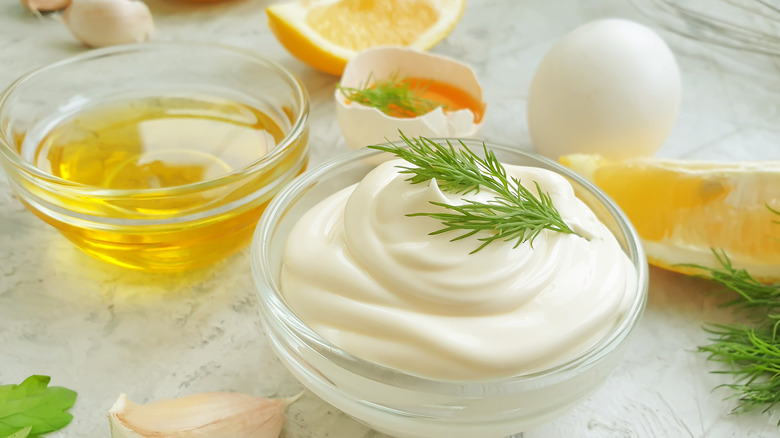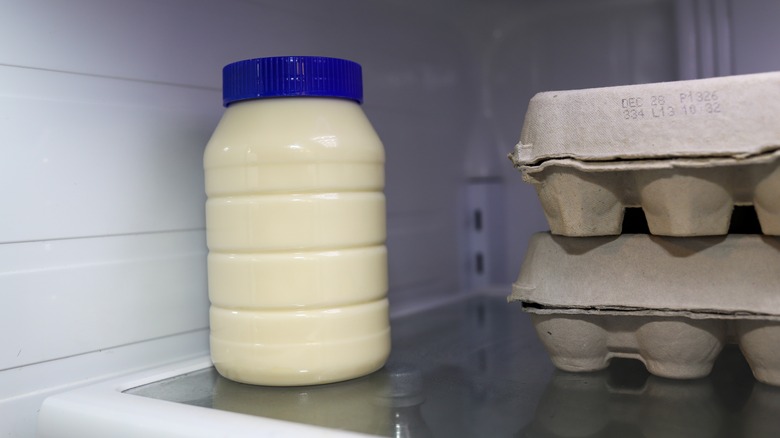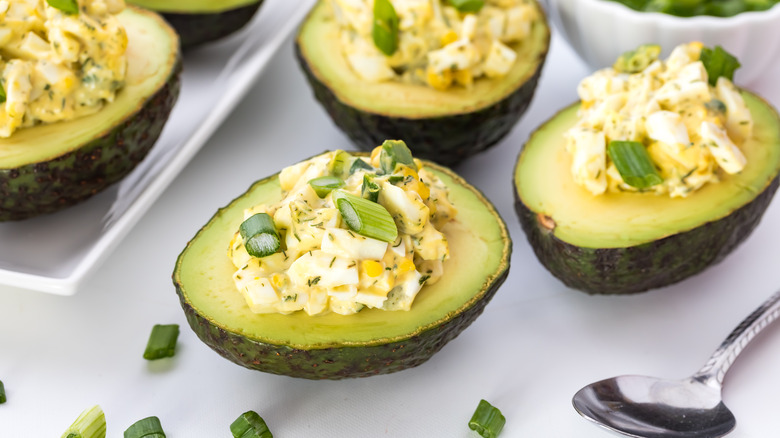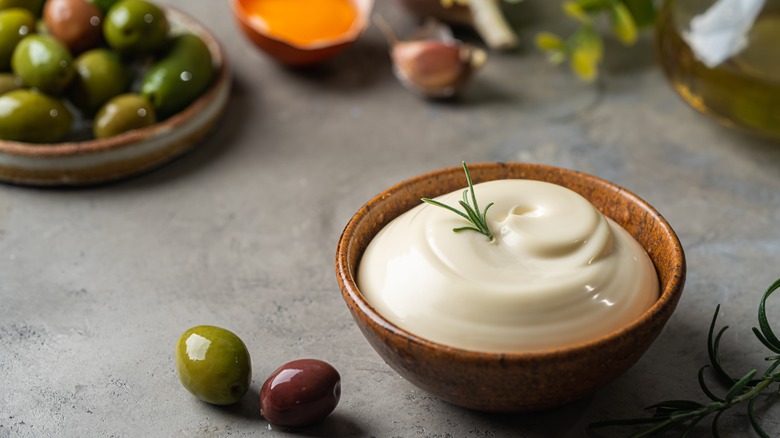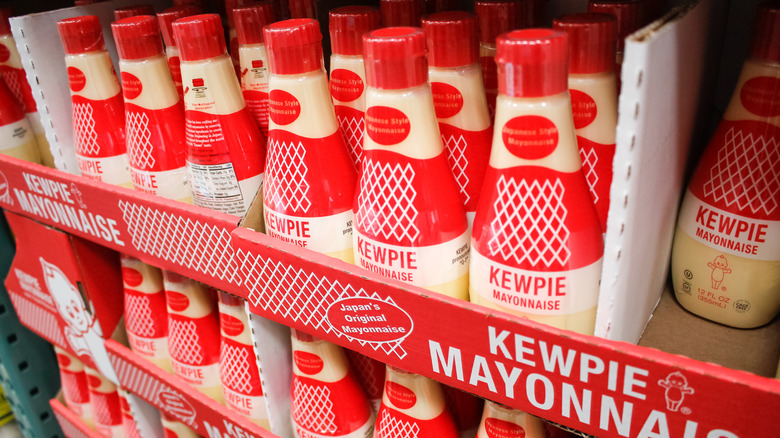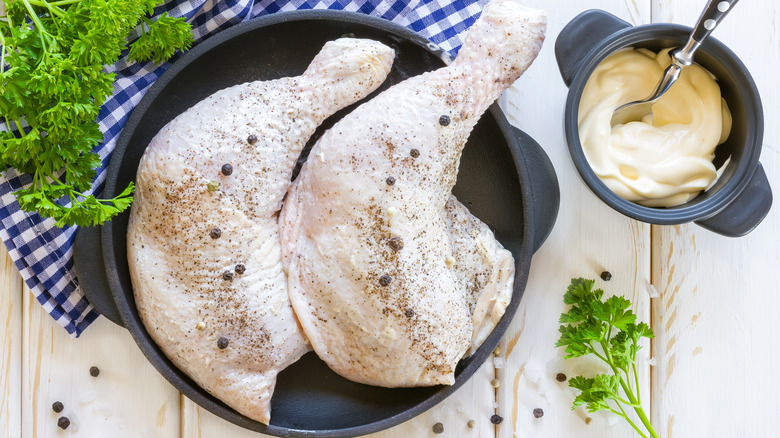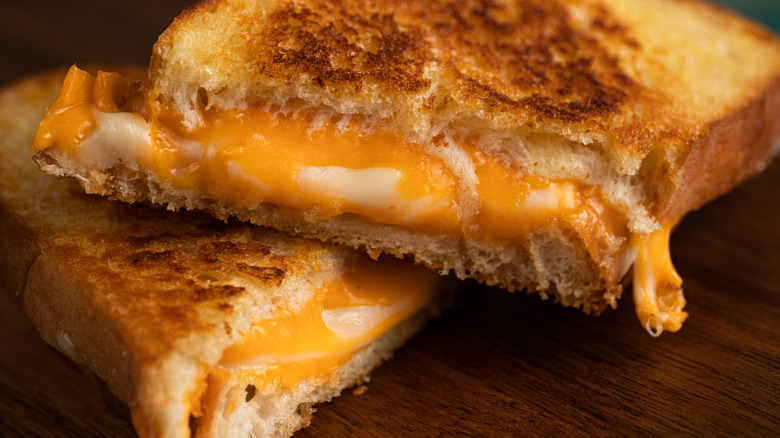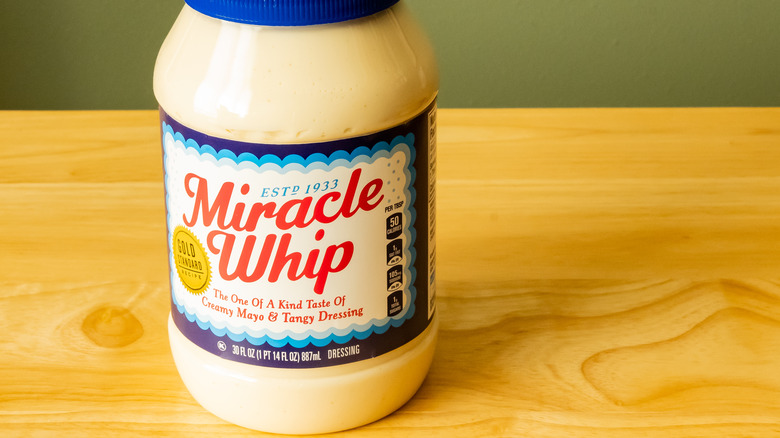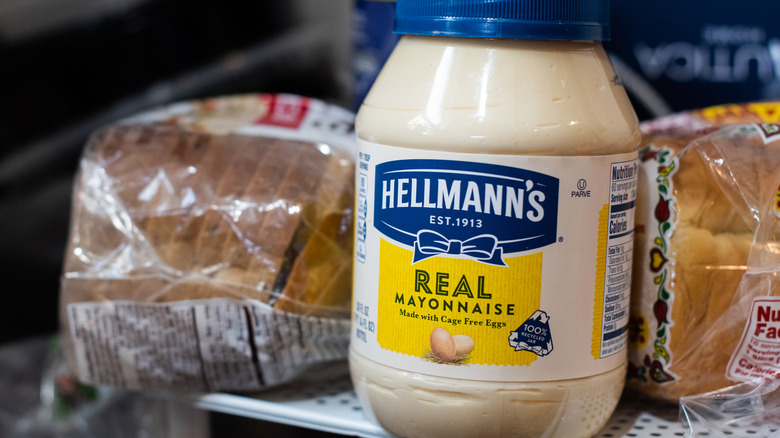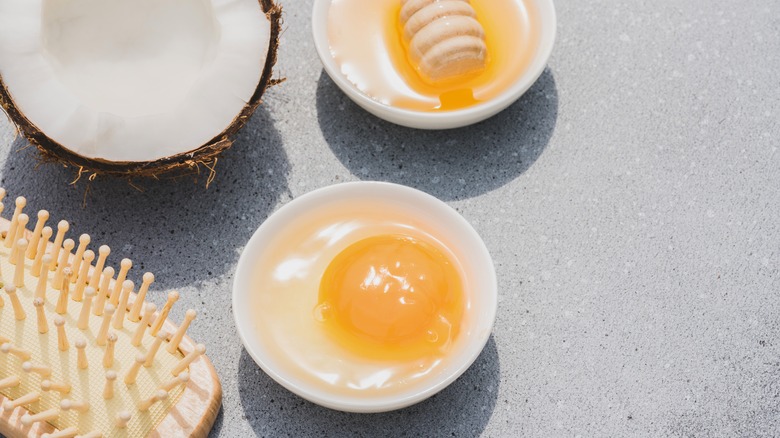Everything You Need To Know About Mayonnaise
Mayonnaise is the most popular condiment in America, beating out fellow burger topper rivals, ketchup, and mustard, by a landslide (via Quartz). Statista reports that almost 280 million Americans are mayonnaise consumers, which means over three-quarters of the U.S. population has a jar of the creamy condiment in their fridge or pantry right now. And we know why: Mayo adds creaminess to potato salad, tames the heat of sriracha, and is a tangy dipper for french fries. And where would egg salad be without mayonnaise?
We understand there are mayo-haters out there. We are not those people. Instead, we celebrate the condiment's attributes with the initial pop of tangy acid, followed by an eggy, custard-like creaminess and velvety smooth texture. Building a better BLT begins with mayo, with the creamy sauce accentuating the smoky fattiness of the bacon and the sweet and savory bite of the tomato.
Still, the oil-based spread is good for much more than as a dressing for salad or sushi. It may be the most beneficial ingredient for solving everyday problems around the house. There's so much to know about this wonderful condiment.
We can thank the French for inventing mayonnaise
Though mayonnaise is the most popular condiment in America, its origins are European. The most popular theory of its creation comes from France. According to The Record, in 1756, the Duke de Richelieu was in the Port of Mahon on Menorca battling the British when his chef first blended oil with egg to create a sauce.
The chef intended to make a cream-based sauce. However, finding the kitchen lacking the necessary dairy, he substituted oil to create a milky sauce. It became a delicious hit, with the chef naming the sauce 'mahonnaise' to mark the Duke's victory.
In "Le Guide Culinaire," the original 1903 text of culinary icon Chef G. Auguste Escoffier, mayonnaise was named the mother sauce of all cold sauces. According to French Guy Cooking, a 1907 English translation of Escoffier's text removed mayo, adding hollandaise. However, the two are not interchangeable as the hollandaise sauce recipe combines a heated base of egg and butter, and mayo is a chilled egg and oil emulsion.
Food professors are trying to set the culinary record straight, declaring the inaccuracy of the translation based on Escoffier's text (via Webology). A number of daughter sauces have been produced out of a mayonnaise base, like tartar sauce, thousand island dressing, and remoulade sauce.
Aioli is more than fancy mayonnaise
Imagine a steaming bowl of steamed mussels without a side of fragrant garlic aioli. The aioli adds the necessary richness needed to round out the flavor of the briny mollusks. Without it, the dish isn't the same.
Escoffier includes aioli in his French cooking guide, noting that it is the butter of Provence. Terres d'Azur asserts that it is a Lenten dish used with fish on days the church restricted the consumption of meat.
Aioli is often considered a fancy name for mayonnaise infused with garlicky flavor, giving the perception that the invention of mayo preceded aioli. However, the creation of the creamy sauce dates back hundreds of years.
Britannica defines aioli, or allioli as it is known in Spain, as a Catalonian sauce in which garlic is beaten with oil and vinegar. What's Cooking In America adds that Roman author and naturalist Pliny the Elder recorded the use of an aioli-like sauce around A.D. 77, noting garlic's healthful qualities and pungent aromas. Aioli and mayonnaise are similar in that they are an emulsion with oil.
Still, their ingredients define the real difference between aioli and mayonnaise. Chef In describes aioli as an emulsion of only garlic whisked to a creamy consistency with oil, whereas mayonnaise includes several additional items. Though some aioli recipes include the addition of various flavorings, acids, and eggs, the classic aioli recipe calls for only two ingredients.
Mayonnaise contains three main ingredients
There are no tricks to how mayonnaise is really made. The ingredients in mayo are straightforward and uncomplicated, produced by emulsifying or blending oil, eggs, and acid. The acid is usually vinegar in a commercial product like Hellmann's Mayonnaise. (Lemon juice also works well when making the spread at home.) Our mayonnaise recipe includes a bit of both acid types, mustard, and a pinch of sugar to even out the zingy flavor.
Though the condiment is creamy white, indicating it could contain milk, dairy is not a part of the recipe. WebMD reports that lecithin in egg yolks creates the emulsion when blended with oil. No dairy or other thickening agents are necessary.
The condiment is easy to make; nevertheless, we recommend following exact measurements and timing will ensure the emulsification occurs without issue. Blending the ingredients out of order or too fast or slow will result in the creamy spread not coming together or breaking into an oily mess as soon as it does.
Does mayonnaise need to be refrigerated?
For years we have been told that mayonnaise needs to be refrigerated once it has been opened, dreading possible food poising if you eat the mayo you accidentally left out overnight. However, is unrefrigerated mayonnaise really unsafe? What really happens if you store an open jar of mayonnaise in the pantry? The FDA and USDA don't recommend leaving mayo unrefrigerated once the jar is unsealed.
However, Hunker recommends room-temperature pantry storage for commercially produced selections, as the commercial brands include pasteurized eggs and stabilizers. Pantry storage is an option for mayonnaise because the acids from the vinegar will ward off the potential growth of bacteria in the condiment.
The pantry is not the optimal storage for your homemade sauce as it won't contain these shelf-stable ingredients. If you are trying to figure out how long condiments last, your jar of Duke's or Hellmann's will stay fresh in the fridge for about two months, according to the USDA.
Mayonnaise is keto-friendly
Depending on your diet and lifestyle, some mayonnaise options may have nutritional value, providing heart-healthy omega-3 and omega-6 fatty acids (via WebMD). If you follow a low-carb keto-friendly diet, mayonnaise is the perfect condiment to slather on raw sashimi, dollop on grilled chicken, or stir into scrumptious avocado egg salad.
Cleveland Clinic defines ketosis as a metabolic state when your body burns fat instead of glucose for energy. Sending your body into ketosis mode occurs by following a restrictive diet that is low in carbohydrates. When the body is faced with limited carbs, it turns to fat for fuel, which can result in weight loss. The diet is laden with fat, which mayo provides in abundance.
A tablespoon of mayonnaise has ten grams of fat, and almost zero carbs or protein (via Very Well Fit.) Ruled explains that mayo is an effortless addition to a keto diet. Having said that, much of the fat in traditional mayo is saturated, which is not ideal for your health. Healthline shares that omega-6 fatty acids are acceptable in moderation, but high consumption can lead to significant health problems.
When selecting or making the best option, the ingredient that matters most when making keto mayonnaise is the oil used as the base of the condiment. Avocado oil is the best for keto-friendly mayonnaise as it primarily consists of monounsaturated fat and is relatively neutral in flavor.
Some types of mayonnaise are healthier than others
Mayonnaise isn't a healthy condiment; there is no denying that. Since the spread has a base of oil and eggs, it has loads of fat and cholesterol. However, some fats are good for you, so deciding which mayo is right for you depends on your health goals and taste preference.
Products like Hellmann's and Miracle Whip are made from soybean oil, which Healthline reports can lead to obesity, heart disease, and arthritis due to a high amount of omega-6 fatty acids.
Thankfully, there are plenty of options on the market. Some of the best mayonnaise brands are made from the more healthful oils. The Washington Post suggests using organic olive oil or avocado oil as the base of your mayo, infusing heart-healthy omega-3 fatty acids in your diet instead of the dreaded omega-6 fats.
According to Brightland, nutrient-wise, olive oil packs a powerful punch of nutrients, including vitamins and minerals. However, the flavor of olive oil, and the spread made from it, is more robust and nuttier than the herbaceous avocado oil. Choosing which oil to use ultimately comes down to your taste.
The adoration of mayonnaise goes beyond America
Kewpie has been a beloved product of Japan for almost 100 years. In recent decades, Kewpie had spread to different corners of the world. The LA Times reports the custard-like spread is prized by acclaimed chefs and is used for adding squiggly lines of creaminess to everything from sushi and salads to pizza and poke bowls. It can even transform your bowl of ramen into a creamy, dreamy flavor bomb.
The initial intention of the sauce's founder was to help promote a healthy lifestyle among the Japanese people (via Kewpie). Kewpie's founder, Toichiro Nakashima, hoped his condiment would encourage Japanese people to eat more vegetables and improve their physique.
Prior to Kewpie's creation in 1925, Nakashima had visited the U.S. and saw Americans stirring the sauce into vegetable salads and topping healthy sandwiches. Nakashima hoped creating a tasty sauce in Japan would elicit the same results.
Are wondering if there is a difference between Kewpie mayo and regular mayonnaise? We have taste tested both and can declare a resounding yes. Traditional mayonnaise brands, like Hellmann's and Kraft, use whole eggs and incorporate water into the mix. Kewpie contains only egg yolks and no egg whites.
Four yolks go into every 500 grams of mayo, increasing the healthy amino acids in the product. The sauce has an extra eggy-rich flavor and a dense, creamy, custard-like texture that is lacking in the American spreads. Kewpie contains no water or preservatives, unlike its American counterparts.
Mayonnaise is the secret to stellar baked goods
Fresh baked goods can taste extra moist and tender through the addition of mayonnaise. According to How Stuff Works, the egg-and-oil-based sauce adds richness and moisture to baked goods. It will transform your next batch of muffins, create decadent cakes, and lead to creamier mashed potatoes. It is the secret ingredient that will change your scrambled eggs forever.
You can swap mayonnaise for oil in baked goods while keeping the egg count the same. As some mayo brands use fewer eggs in the product, keeping a recipe's egg count will ensure the dish will turn out as you intended, with an extra boost of mouthwatering richness.
Not only will the mayo add moisture, but it will also add flavor, with the vinegar in the sauce enhancing the sweet and savory notes of the dish, rounding out the taste profile. Mayonnaise is also the secret ingredient that will change your homemade biscuits forever.
Mayo is the marinade that meat has been waiting for
Adding mayo to protein turns a casual weeknight dinner into something your family will think took you hours to achieve. It is the condiment you should use for ultra-moist baked chicken, beef, and fish.
The New York Times explains that the oil-and-water base of mayonnaise comes together in an emulsion. In creating this emulsion, two different ingredients combine to create a dense texture that will not separate.
Since mayonnaise has a base of oil and water, its emulsion breaks up the fat into microscopic droplets that disperse into the water, preventing them from coming back together. The result is a fluffy spread that evenly coats protein in a creamy marinade.
By slathering mayo on a steak, chicken breast, fish, or even a whole turkey, the condiment will adhere to the protein like a crust. When heated, the water in the mayo evaporates, leaving behind an eggy-rich oil-infused exterior, locking in the protein's juices and keeping any baked or roasted food moist.
Using mayonnaise for making a steak at home is one of Alton Brown's best cooking tips.
Mayonnaise creates the crispiest crust
Semi-solid mayonnaise sticks to anything it touches, making it a quick and easy glue for adding a crust or coating to anything. When making Mexican street corn, combining mayo with herbs, spices, and crema will help bind the ingredients to the corn on the cob and hold the dusting of cojita cheese and cilantro in place. When preparing parmesan-crusted tilapia, the mayo adheres to the fish, holding the crusting of breadcrumbs and cheese in place.
If you'd like to create the ultimate grilled cheese sandwich, we recommend slathering a heaping spoonful of mayo on the outside of the bread before grilling. The coating of mayo will ensure the sandwich has an evenly browned, crispy toasted crust while keeping the inside of the bread soft and tender. To get the most out of your mayo, do yourself a favor and cook the sandwich in a cast iron skillet with consistent high-heat distribution throughout the pan, which will give the sandwich a nice crispy sear.
If you are counting calories, opt for Miracle Whip
Some love Miracle Whip, while others cannot stand it. The history of Miracle Whip dates back to the Great Depression. According to Dining Chicago, in the depths of the depression era, mayonnaise producer Kraft Foods, saw sales for its popular spread declining. Households opted to make the condiment instead of buying a pre-made product.
The people at Kraft created the miracle machine that could emulsify pre-measured ingredients, continuously creating a smooth, well-blended spread at a lower cost than traditional mayonnaise production. Kraft debuted the whipped product with a unique sweet and tangy flavor at the 1933 World's Fair in Chicago, naming the blend of mayonnaise and salad dressing Miracle Whip (via Kraft Foods).
Though similar, key ingredients make miracle whip and mayo different. Both contain a base of oil, eggs, and acid. However, as Healthline reports, Miracle Whip has less fat and substitutes it with high fructose corn syrup, modified cornstarch, and added sugar, each of which can cause health issues and each of which traditional mayonnaise lacks.
As Miracle Whip has less oil, it does have fewer calories and less fat, about half as much as conventional mayonnaise. But, unlike mayo, Miracle Whip includes carbohydrates in the form of sugars.
There's good reason to use the popular brands
According to Zippa, Hellmann's is the top-selling mayonnaise brand in the world. Slate reports the reason why so many people love Hellmann's, noting that every jar delivers everything you could want from a creamy spread. Hellmann's delivers perfect consistency and texture with balanced, slightly sweet and savory flavors.
However, if you live on the West Coast, you may have yet to learn what is so special about Hellmann's. To you, Best Foods is likely the most popular mayonnaise brand in the world. And you are correct; as KTLA reports, Hellmann's and Best Foods are not only the most popular mayonnaise brand in the world, they are the same.
Unilever is the parent company for both brands. Hellman's began when founder Richard Hellmann began using his homemade sauce on sandwiches at his family's New York deli in 1913. The company was sold to Best Foods of California in the 1930s.
At the time, Hellmann's was very popular, particularly on the East Coast, so Best Foods only changed the name for the product west of Colorado. Today, Hellmann's (and it would seem Best Foods) is a highly successful brand that is sold in over 65 countries worldwide, predominantly under the "Hellmann's" name.
Mayo's household uses go beyond the kitchen
Mayonnaise is delicious as a spread and a sauce. It also performs double duty, treating problems around the house as a natural cleaner and stain remover. Today's Homeowner recommends using mayonnaise to remove watermarks on wood.
Rubbing a dollop of mayo into the mark as soon as it occurs will remove the stain while adding moisturizing, nourishing oil to the wood. Similarly, suppose your little ones use your bedroom wall as a canvas for their Crayola masterpiece. In that case, Apartment Therapy asserts that a swipe of mayo across the crayon marks will remove the stain without harming the paint.
Mayo is a gentle polishing agent, helpful for old pianos that have more yellow keys than ivory. Piano Reviewer suggests gently rubbing mayo into the keys with a microfiber cloth as this will cause the bacteria to lighten the natural ivory without damaging the keys.
If the roadwork in your neighborhood's intersection has splashed road tar onto your automobile's paint, turn to mayo to remove the crud. New England Living Today advises rubbing the tarred area with a dollop of the condiment and leaving it to set for a few minutes. The tar will be gone when you rub it off, and the finish should remain unharmed. The Washington Post reports that mayo even helped save baby turtles during a recent oil spill in Israel.
Use mayonnaise instead of your favorite conditioner
The health of your hair will get a boost from the jar of mayonnaise sitting in your fridge. Oils and eggs are two of the best ingredients for healthy hair. Medical News Today reports that massaging protein-rich egg yolks into your hair could spur hair growth, promote shine, and enhance the softness of your hair.
Healthline adds that using mayonnaise as a hair mask could be helpful to tame the fizziness of dry hair or calm the wave of unyielding curls. The oil base of the mayo replaces the natural oils in hair, giving it a punch of conditioning moisture. The benefits are likely best for those with curls.
Additionally, if your bubble gum goes rouge with a massive pop into your hair, mayo is ideal for removing the sticky mess from your face and hair while keeping your hair intact: The Houston Chronicle advises rubbing a bit of real mayonnaise into the gum-ridden hair and then rubbing it gently with a towel.
